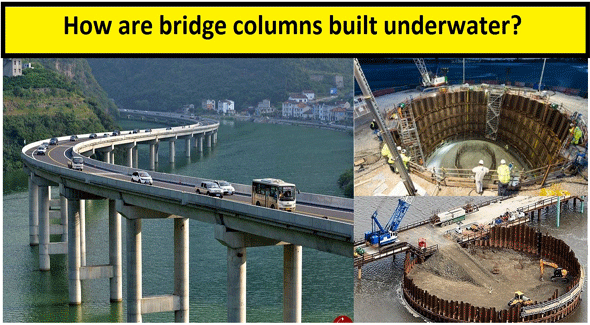Some useful techniques to construct bridge columns underwater
- Concrete Cost Estimator
- Concrete Continuous Footing
- Landscape Bidding and Estimating
- Construction Cost Estimating
- Concrete and steel cost estimation
- Construction Cost Estimate Breakdown
- Construction Estimating Worksheet
- Home Construction Cost Estimate
- Estimate Pricing Sheet
- Sheet for General Contractor
- Construction Cost Estimate
- Labor Materials Cost Estimator
- Masonry Estimating Sheet
- Sheet for Building Contractor
- Construction Schedule Bar chart
- General Cost Estimator Sheet
- General Construction Estimate
- Building and Road Estimating Sheet
- Detailed expense estimates
- Door and Window Takeoff Sheet
- General Construction Cost Estimating Sheet

In this exclusive construction article, you will learn the process for erecting the columns or pillars underwater by setting up their exact positions.
Based on the construction over waters, different types of techniques like type of sand underwater, type of water, weather conditions of the area and depth of water are mostly applied.
In case of shallow waters, the piers (a type of pillar) are constructed on the temporary foundation to support the structure located above.
In case of deep water level where the conditions of soil are not supportive, several techniques are employed to uplift the piers.
Here, lies the importance of cofferdam technique. In technical term, cofferdam stands for a structure that holds water and soil in a specific area.
Depth of water is not a concern for constructing cofferdam. Now in a cofferdam, an underwater bounded room type structure is built up and it is attached with soil and water.
After that the water and surplus soil are discharged through a pump so that the area becomes dry. It needs constant pumping out of the water and other unwanted materials.
Cofferdam walls are usually formed with sheet piles supported by wailers, internal braces, and cross braces. Cofferdams stand for temporary structures and are detached once the piers are erected to support the bridge. Because of their temporary nature, cofferdams construction materials are found in template form.
The following three types of cofferdams are found :-
Braced Cofferdams: It belongs to a single wall of sheet piles that is provided to the excavated site on the ground. It is applicable for comparatively shallow waters with approx 12 meters depth.
Cellular cofferdam: They are suitable when it is not possible to utilize the cross braces. Under this situation, the cofferdam is stable as a result of the forces operate on it.
Double walled sheet piled cofferdam: They contain two parallel rows of sheet piles pushed to site ground and connected to each other through tie rods. The space is then filled with a material like sand or gravel for the completion of the work.

- Application of concrete calculator
- Roofing Calculator can streamline the roof estimating process
- House construction cost calculator
- Engineering column design excel spreadsheet
- Material Estimating Sheet with Excel
- Materials List and Cost Estimate Worksheet
- Concrete Slab Estimating Calculator Sheet
- Common types of foundations for buildings
- Online calculation of construction materials
- Estimating with Excel for the Small Contractor
- Concrete Beam Design Spreadsheet
- Virtual Construction Management app for construction
- Autodesk’s Project Skyscraper
- Reed Construction’s Reed Insight
- Manage your construction project documentation
- Costimator, the popular cost estimating software
- On Center Software for construction professionals
- Free Construction Estimating Software
- Plumbing Calc Pro
- Cost Estimate Worksheet
- HVAC Piping Quantity Takeoff Worksheet
- Construction Estimating Software Sheet
- Estimate Cost Templates
- Construction Punch List
- Construction cost estimating template consisting estimating basic
- Gantt Chart Template for Excel
- Download Civil Engineering Spreadsheets with Verification
- The Building Advisor Estimating and Budgeting Worksheet
- Spreadsheet for design of concrete bridge
- Construction Estimating Software Free








